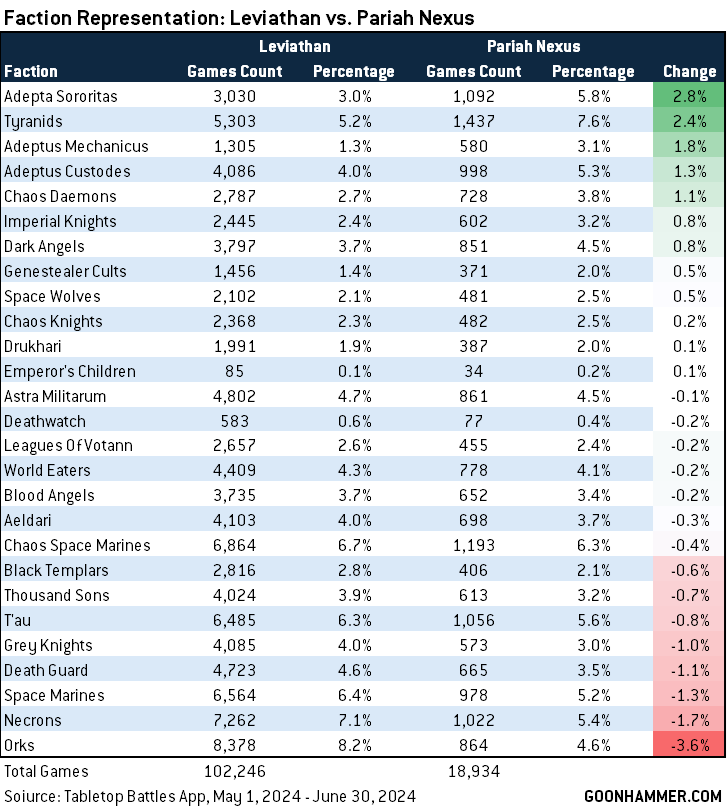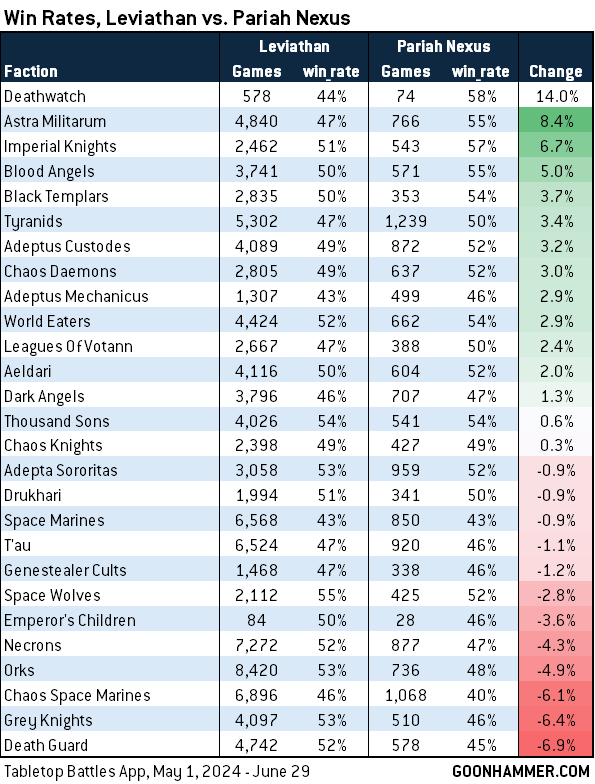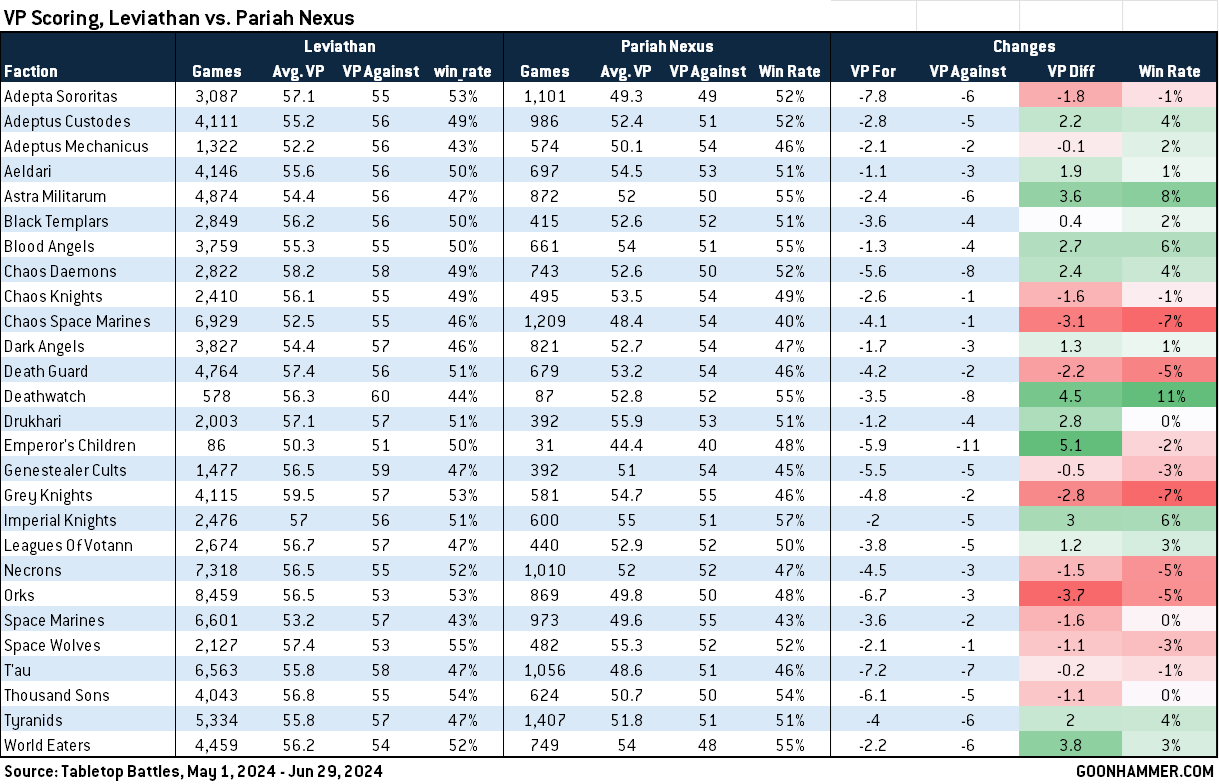In Hammer of Math we look at statistics and probability in Warhammer. This week, we’re looking at data collected from games logged using the Tabletop Battles App.
It’s been two weeks since we released our Pariah Nexus update of Tabletop Battles. Or, more accurately, two weekends – something like 90% of our games logged in the app happen on weekends, to the point that most of our data collection processes only fire on Mondays. At the time of this writing, we’ve collected data on just under ten thousand games of Warhammer 40,000 played using the Pariah Nexus GT missions – 9,467, to be exact – and that’s more than enough data to start talking about how the game has changed with Pariah Nexus.
Before we dive in to the stats, it’s worth talking about where this data comes from – the data in this article comes from Goonhammer’s Tabletop Battles App, and specifically completed games logged with the Pariah Nexus GT Missions.
If you haven’t already, go download the app. It is hands-down the best app out there for tracking games of Warhammer 40k, and with support for 10th edition and the Pariah Nexus missions pack there is no better way to track your scores and secondary objectives. It even has correct terrain deployment maps which correct the typos in the packet published by Games Workshop.
Note: If you already have an Administratum account, that login will also be your Tabletop Battles login – just use the same account you’ve already made. If you are creating a new account, you can use that account for Administratum later!
Factions
Let’s start by breaking down the games a bit to better understand the sample. The recent dataslate/points update/rules update also came with two new codexes, and it’s worth looking at the way faction representation has changed over the last two weeks. To do this we’re comparing our sample of 9,467 games to everything played with the Leviathan GT packet after May 1, 2024. Doing so gives us a sample of about 51 thousand games to look at, and when we compare faction comp between the two, here’s what the results look like:

Why are the game totals larger than I said?
Looking at this shows some fun swings. Despite having points higher than we might have originally anticipated, the Adepta Sororitas are the biggest winners in the sample, jumping nearly 3 percentage points in representation. Tyranids are right behind them in terms of gain but are now the most played faction in the game with 7.6% of Pariah Nexus games logged in the past two weeks. Chaos Space Marines are the second most played, but lost a step following their nerfs, dropping nearly half a percentage point to 6.3% of armies played. The biggest losers here are Orks, who still have a healthy 4.6% representation, but dropped nearly 4 percentage points with the nerfs to Bully Boyz and Green Tide.
Other big climbers? The Adeptus Custodes and Adeptus Mechanicus both saw big jumps, as did Chaos Daemons on the back of their large buffs. Meanwhile, you can see the salt flowing off Black Templars, Thousand Sons, Grey Knights, and Death Guard players.
Tyranids being the most played faction is incredibly interesting. Sure they only increased 50% compared to the percentage of Admech games doubling, but suddenly being the game’s most-played faction is another indicator of how impactful it can be for a faction to be part of the launch box/starter boxes for an edition. For the past two editions now we’ve seen over-representation for factions in those boxes – Death Guard in 8th edition and Necrons in 9th – which has carried over to the following editions as players are just more likely to have those armies and can jump to them when they’re strong.
Win Rates
Big changes to points and rules mean big changes to win rates. Let’s take a look at how win rates changed from Leviathan in May to Pariah Nexus in June:

First off: Big props to the one person playing Deathwatch and absolutely crushing their friends. You’re single-handedly throwing off all the stats. When we look at the rest of the factions, we can see that there has been a ton of movement. Guard may have been hit with some nerfs in the last dataslate, but they received a stealth buff in the form of the Rogal Dorn dropping 20 points, and it was already pretty good. The result is that Guard players who were able to adapt saw the faction’s win rate improve by more than 8 percentage points. Imperial Knights also saw a massive jump, and one that wasn’t unexpected given the point drops and new ability to walk through walls. Custodes, Daemons, and Adeptus Mechanicus all saw major bumps as well.
On the losing end of things well, Death Guard dropped substantially alongside Grey Knights, Chaos Space Marines, Orks, and Necrons. Each faction received nerfs, though not normally enough to merit a drop this big – what we’re looking out is likely a compounded factor of reduced power and better players dropping those factions in favor of other, stronger options. I was already planning to move to Thousand Sons well before the dataslate, and the changes to both factions just made that easier.
That said, 45% as the bottom of the band isn’t bad at all – if it holds that’s pretty solid, and it’ll be worth keeping an eye on that upper end and seeing if Sisters, Imperial Knights, Blood Angels, and Thousand Sons moving forward to see how their win rates change.
Scoring
Winning isn’t just a function of the player but a function of scoring – both what you can put up in a game and what your opponent scores. We can provide additional context to some of those stats by looking at scoring by faction.
This is an incredibly dense chart and there’s a ton going on with it so let’s dig into the details of it. First off, this chart shows the average VP scored by and for each faction in the Leviathan GT mission played after May 1st, 2024, and in the Pariah Nexus GT missions played before July 1, 2024. Note that these scores are the sum of primary and secondary scores and do not include the Battle-ready 10 points, putting the average player score around 60-70 VP if you include that Battle-Ready score. That’s in line with tournament results, if a little lower.
The first thing to note here is that scoring in Pariah Nexus is down on average. The average VP scored by players in Leviathan was 55.8 VP per game, and in Pariah Nexus that total has dropped to 51.8, a difference of 4 VP. This was something we predicted in our Pariah Nexus review, and it’s interesting to be able to quantify it. This also gives us our baseline when looking at factions – we should expect each faction to see a drop off in scoring of around 4 VP, and the factions which avoid that drop will improve in win rate and the factions that don’t will not. Likewise, we expect to see each faction give up 4 fewer VP as scoring drops.
On the far right of the table we’ve included columns showing the change in average VP scored for each faction and the average VP allowed, along with the change in point differential and win rate. The correlation here is very strong (r=0.788) between changes in that differential and win rate, as you might expect. The differential change also helps us explain why some factions haven’t moved more – for example, T’au armies no longer give up massive amounts of points on Bring it Down and so average VP scored against them has dropped by 7. However this is countered by the fact that T’au scoring has also gone down by an average of 7.2 VP, and the result is their win rate declined slightly. Some of this is that T’au opponent have just largely switched to Tactical Scoring.
The big losers here are the Orks (-3.7), Chaos Space Marines, (-3.1), Grey Knights (-2.8), and Death Guard (-2.2). That said, the changes aren’t as stark as they are for some other factions. Death Guard for example are positively average in their shift in VP scored (-4.2), but their opponents only average 2 fewer VP scored per game, and the resulting 5% drop in win rate feels disproportionate compared to other factions. There’s more to discover with the faction’s performance shift but I suspect losing Nurglings plays a major role here.
The big winners here are the Astra Militarum, who give up fewer VP and drop an average of only 2.4 VP per game, and Imperial Knights aren’t far behind. Generally speaking the factions taking the softest hits in VP scoring tended to be faster armies with access to cheaper action units, though that may include Assassins and Imperial Agents in the case of Imperial Knights and Adeptus Custodes lists.
What This All Means
Of course none of this is set in stone. While I’m generally not a proponent of the “meta adapting” – I’ve consistently shown with data that the meta only “adapts” to overpowered factions by adopting them – I do think that with this many changes it will take time for new strategies and lists to emerge, particularly where armies have room to adjust. There may be a vehicle-heavy Death Guard build that has legs (read: treads) and can compete, while Adepta Sororitas players will find they can’t “go wide” with their strategy any more but can still dish out tremendous damage.
Next Week: Primary, Secondary, and Secret Missions
That wraps up our look at the data for this week. Next week we’ll take a look at scoring for Primary and Secondary Missions and how those have changed in Pariah Nexus, plus we’ll take a look at Secret Missions and how those are being scored.
Have any questions or feedback? Drop us a note in the comments below or email us at contact@goonhammer.com. Want articles like this linked in your inbox every Monday morning? Sign up for our newsletter. And don’t forget that you can support us on Patreon for backer rewards like early video content, Administratum access, an ad-free experience on our website and more.





